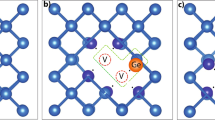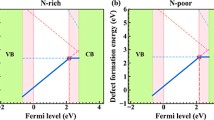Abstract
Defect complexes have a significant impact on the structural, electronic, optical and electrical properties of semiconductors. Several defect complexes formed by n-type and p-type atoms in Ge have been implemented for the development of improved modern microelectronic devices. However, there is no reported study on the substitutional-interstitial defect complexes formed by trivalent atoms in Ge. This paper presents a hybrid density functional theory study of the structural, electronic, formation and defect levels induced by the trivalent substitutional-interstitial (B\(_\textrm{Ge}\)B\(_\textrm{i}\), Al\(_\textrm{Ge}\)Al\(_\textrm{i}\), Ga\(_\textrm{Ge}\)Ga\(_\textrm{i}\) and In\(_\textrm{Ge}\)In\(_\textrm{i}\)) defect complexes in Ge. The formation energy results showed that the trivalent substitutional-interstitial defect complexes in Ge were formed with relatively low energy. Ga\(_\textrm{Ge}\)Ga\(_\textrm{i}\) under equilibrium conditions is the most energetically favourable, with a formation energy of 3.95 eV. All trivalent atoms are bound with their respective substitutional and interstitial atoms without dissociation. With respect to their ability to form as a defect cluster, the In\(_\textrm{Ge}\)In\(_\textrm{i}\) is the most stable defect complex, with a binding energy of 2.91 eV. Except for the Ga\(_\textrm{Ge}\)Ga\(_\textrm{i}\), all studied defect complexes are electrically active. The B\(_\textrm{Ge}\)B\(_\textrm{i}\) and Al\(_\textrm{Ge}\)Al\(_\textrm{i}\) induced a single acceptor level, while the In\(_\textrm{Ge}\)In\(_\textrm{i}\) induced active donor levels. The acceptor defect level induced by the B\(_\textrm{Ge}\)B\(_\textrm{i}\) is deep, and that of the Al\(_\textrm{Ge}\)Al\(_\textrm{i}\) is shallow, close to the conduction band. The results of this study are important, as they provide theoretical insights into the experimental characterization of the substitutional-interstitial defect complexes formed by trivalent impurities in germanium, which could help to improve Ge-based microelectronic devices.




Similar content being viewed by others
References
P. Rajesh, Some Studies on the Metallic Ion Implanted Semiconductors and their Possible Applications. Ph.D. thesis, Jadavpur University (2015).
W.A.. Jabbara, A. Mahmood, and J. Sultan, Modeling and characterization of optimal nano-scale channel dimensions for fin field effect transistor based on constituent semiconductor materials. TELKOMNIKA Telecommun. Comput. Electron. Control 20(1), 221 (2022).
J. Yang, K. Liu, X. Chen, and D. Shen, Recent advances in optoelectronic and microelectronic devices based on ultrawide-bandgap semiconductors. Prog. Quantum Electron. 83(100), 397 (2022).
S. Chander, S.K. Sinha, R. Chaudhary, and A. Singh, Ge-source based l-shaped tunnel field effect transistor for low power switching application. Silicon 14, 1 (2021).
E. Igumbor, Hybrid functional study of point defects in germanium. Ph.D. thesis, University of Pretoria (2017).
N. Tillner, C. Frankerl, F. Nippert, M.J. Davies, C. Brandl, R. Lösing, M. Mandl, H.J. Lugauer, R. Zeisel, A. Hoffmann, and A. Waag, Point defect-induced UV-C absorption in aluminum nitride epitaxial layers grown on sapphire substrates by metal-organic chemical vapor deposition. Phys. Status solidi b 257(12), 2000278 (2020).
E. Ekimov, M. Kondrin, V. Krivobok, A. Khomich, I. Vlasov, R. Khmelnitskiy, T. Iwasaki, and M. Hatano, Effect of Si, Ge and Sn dopant elements on structure and photoluminescence of nano-and microdiamonds synthesized from organic compounds. Diam. Relat. Mater. 93, 75 (2019).
A. Bolshakov, V. Fedorov, K.Y. Shugurov, A. Mozharov, G. Sapunov, I. Shtrom, M. Mukhin, A. Uvarov, G. Cirlin, and I. Mukhin, Effects of the surface preparation and buffer layer on the morphology, electronic and optical properties of the Gan nanowires on Si. Nanotechnology 30(39), 395602 (2019).
V.E. Gora, F.D. Auret, H.T. Danga, S.M. Tunhuma, C. Nyamhere, E. Igumbor, and A. Chawanda, Barrier height inhomogeneities on Pd/n-4H-SiC schottky diodes in a wide temperature range. Mater. Sci. Eng. B 247(114), 370 (2019).
J. Lyons, A. Janotti, and C. Van de Walle, Carbon impurities and the yellow luminescence in Gan. Appl. Phys. Lett. 97(15), 152108 (2010).
A. Hernandez, M.M. Islam, P. Saddatkia, C. Codding, P. Dulal, S. Agarwal, A. Janover, S. Novak, M. Huang, T. Dang, and M. Snure, MOCVD growth and characterization of conductive homoepitaxial Si-doped Ga2O3. Res. Phys. 25, 104167 (2021).
A.E. Rugar, H. Lu, C. Dory, S. Sun, P.J. McQuade, Z.X. Shen, N.A. Melosh, and J. Vuckovic, Generation of tin-vacancy centers in diamond via shallow ion implantation and subsequent diamond overgrowth. Nano Lett. 20(3), 1614 (2020).
E.A. Anber, D. Foley, A.C. Lang, J. Nathaniel, J.L. Hart, M.J. Tadjer, K.D. Hobart, S. Pearton, and M.L. Taheri, Structural transition and recovery of Ge implanted \(\beta \)-Ga2O3. Appl. Phys. Lett. 12, 117(15) (2020).
S.R. Christopoulos, E. Sgourou, R. Vovk, A. Chroneos, and C. Londos, Isovalent doping and the CiOi defect in germanium. J. Mater. Sci. Mater. Electron. 29(5), 4261 (2018).
M. El Kurdi, M. Prost, A. Ghrib, S. Sauvage, X. Checoury, G. Beaudoin, I. Sagnes, G. Picardi, R. Ossikovski, and P. Boucaud, Direct band gap germanium microdisks obtained with silicon nitride stressor layers. ACS Photon. 3(3), 443 (2016).
Q. Wei, J. Song, C. Zhou, W. Bao, Y. Miao, H. Hu, H. Zhang, and B. Wang, Study of energy band modulation of Ge-based material system for monolithic optoelectronic integration chips. Mater. Express 7(5), 369 (2017).
U. Södervall, M. Friesel, and A. Lodding, Atomic transport of trivalent impurities in silicon: diffusion, isotope effects, activation volumes. J. Chem. Soc. Faraday Trans. 86(8), 1293 (1990).
P. Gong, Y.J. Li, Y.H. Jia, Y.L. Li, S.L. Li, X.Y. Fang, and M.S. Cao, Comparative study on transport properties and scattering mechanism of group III doped SiC nanotube. Phys. Lett. A 382(35), 2484 (2018).
M. Amato, T. Kaewmaraya, and A. Zobelli, Extrinsic doping in group IV hexagonal-diamond-type crystals. J. Phys. Chem. C 124(31), 17290 (2020).
C.R. Helms and E.H. Poindexter, The silicon-silicon dioxide system: its microstructure and imperfections. Rep. Prog. Phys. 57(8), 791 (1994).
S. Suthaharan, P. Iyngaran, N. Kuganathan, and A. Chroneos, Defects, diffusion and dopants in the ceramic mineral lime-feldspar. J. Asian Ceram. Soc. 9(2), 570 (2021).
E. Igumbor, E. Omotoso, and W.E. Meyer, In Nano Hybrids and Composites, vol. 16 (Trans Tech Publ), pp. 47–51 (2017).
E. Igumbor, R.E. Mapasha, and W.E. Meyer, Ab_initio study of aluminium impurity and interstitial-substitutional complexes in Ge using a hybrid functional (HSE). J. Electron. Mater. 46(7), 3880 (2017).
J. Adey, R. Jones, D. Palmer, P. Briddon, and S. Öberg, Theory of boron-vacancy complexes in silicon. Phys. Rev. B 71(16), 165211 (2005).
E. Igumbor, G. Dongho-Nguimdo, R.E. Mapasha, and W.E. Meyer, Electronic properties and defect levels induced by group III substitution-interstitial complexes in Ge. J. Mater. Sci. 54(15), 10798 (2019).
P. Deák, A. Gali, A. Sólyom, A. Buruzs, and T. Frauenheim, Electronic structure of boron-interstitial clusters in silicon. J. Phys. Condens. Matter 17(22), S2141 (2005).
J. Weber, W. Koehl, J. Varley, A. Janotti, B. Buckley, C. Van de Walle, and D. Awschalom, Defects in SiC for quantum computing. J. Appl. Phys. 109(10), 102417 (2011).
E. Igumbor, H.T. Danga, E. Omotoso, and W.E. Meyer, Defect levels induced by double substitution of b and n in 4H-SiC. Nucl. Instrum. Methods Phys. Res. Sect. B 442, 41 (2019).
D. Sprouster, C. Campbell, S. Buckman, G. Impellizzeri, E. Napolitani, S. Ruffell, and J. Sullivan, Defect complexes in fluorine-implanted germanium. J. Phys. D Appl. Phys. 46(50), 505310 (2013).
J. Kujala, T. Südkamp, J. Slotte, I. Makkonen, F. Tuomisto, and H. Bracht, Vacancy-donor complexes in highly n-type Ge doped with as, p and sb. J. Phys. Condens. Matter 28(33), 335801 (2016).
A. Abiona, Palladium-defect complexes in germanium: experimental and density functional theory studies of defect pairing in group IVsemiconductors. Ph.D. thesis, UNSW Sydney (2014).
J. Heyd, G.E. Scuseria, and M. Ernzerhof, Hybrid functionals based on a screened coulomb potential. J. Chem. Phys. 118(18), 8207 (2003).
G. Kresse and J. Furthmüller, Efficient iterative schemes for ab initio total-energy calculations using a plane-wave basis set. Phys. Rev. B 54(16), 11169 (1996).
G. Kresse and D. Joubert, From ultrasoft pseudopotentials to the projector augmented-wave method. Phys. Rev. B 59(3), 1758 (1999).
P. Deák, B. Aradi, T. Frauenheim, E. Janzén, and A. Gali, Accurate defect levels obtained from the HSE06 range-separated hybrid functional. Phys. Rev. B 81(15), 153203 (2010).
E. Igumbor, R.C. Andrew, and W.E. Meyer, Rare earth interstitials in Ge: a hybrid density functional theory study. J. Electron. Mater. 46(2), 1022 (2017).
P. Śpiewak, J. Vanhellemont, K. Sueoka, K. Kurzydłowski, and I. Romandic, Ab-initio simulation of self-interstitial in germanium. Mater. Sci. Semicond. Process. 11(5–6), 328 (2008).
H. Tahini, A. Chroneos, R. Grimes, U. Schwingenschlögl, and H. Bracht, Diffusion of e centers in germanium predicted using GGA+ Uapproach. Applied Physics Letters 99(7) (2011).
E. Igumbor, K. Obodo, and W.E. Meyer, Ab initio study of MgSe self-interstitial (Mgi and Sei). Solid State Phenom. 242, 440 (2015).
F. Morin and J.P. Maita, Conductivity and hall effect in the intrinsic range of germanium. Phys. Rev. 94(6), 1525 (1954).
E. Igumbor, O. Olaniyan, G.M. Dongho-Nguimdo, R. Mapasha, S. Ahmad, E. Omotoso, and W.E. Meyer, Electronic properties and defect levels induced by n/p-type defect-complexes in Ge. Mater. Sci. Semicond. Process. 150, 106906 (2022).
C. Freysoldt, J. Neugebauer, and C.G. Van de Walle, Electrostatic interactions between charged defects in supercells. Phys. Status Solidi b 248(5), 1067 (2011).
E. Igumbor, C. Ouma, G. Webb, and W. Meyer, Ab-initio study of germanium di-interstitial using a hybrid functional (HSE). Physica B 480, 191 (2016).
J.C. Slater, Atomic radii in crystals. J. Chem. Phys. 41(10), 3199 (1964).
L.C.T. Cao, L. Hakim, and S.H. Hsu. In Characteristics and Applications of Boron (IntechOpen), (2022).
K. Choe, M. Hogsed, N. Miguel, J. McClory, and J. Kouvetakis, Displacement Damage Effects in Germanium tin Leds. Air Force Institute of Technology Wright-Patterson AFB United States: Tech. rep (2020).
Acknowledgments
This work is based on research supported in part by the National Research Foundation (NRF) of South Africa (Grant unique reference number 98961). The opinions, findings and conclusions expressed are those of the authors, and the NRF accepts no liability whatsoever in this regard. Emmanuel Igumbor is grateful to the University of Johannesburg for funding and the Center for High Performance Computing (CHPC) Cape Town for providing computational resources.
Author information
Authors and Affiliations
Corresponding author
Ethics declarations
Conflict of interest
The authors declare that they have no conflict of interest.
Additional information
Publisher's Note
Springer Nature remains neutral with regard to jurisdictional claims in published maps and institutional affiliations.
Rights and permissions
Springer Nature or its licensor (e.g. a society or other partner) holds exclusive rights to this article under a publishing agreement with the author(s) or other rightsholder(s); author self-archiving of the accepted manuscript version of this article is solely governed by the terms of such publishing agreement and applicable law.
About this article
Cite this article
Igumbor, E., Dongho-Nguimdo, M., Mapasha, E. et al. Trivalent Atom Defect-Complex Induced Defect Levels in Germanium for Enhanced Ge‑Based Device Performance. J. Electron. Mater. 53, 1903–1912 (2024). https://doi.org/10.1007/s11664-023-10902-z
Received:
Accepted:
Published:
Issue Date:
DOI: https://doi.org/10.1007/s11664-023-10902-z




